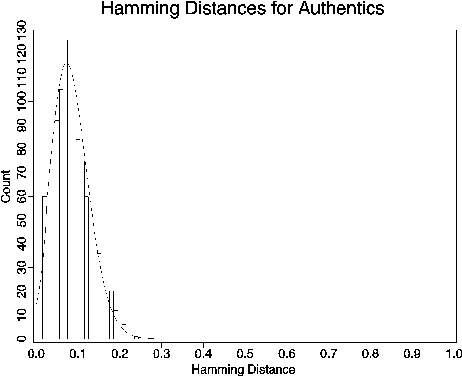Next: Equivalent Bernoulli Trials Up: Performance Previous: Imposters' Hamming Distances
![]()
![]()
![]()
Next: Equivalent Bernoulli Trials Up: Performance Previous: Imposters' Hamming Distances

Figure 10: Hamming distances between pairs of different iris codes for each given
iris, allowing for n=7 different degrees of eye or head tilt.
Figure 10 shows the distribution of Hamming distances computed between 1,208
pairs of different images of given irises (``authentics"). Different images
of the same iris never yield a Hamming distance of zero, because of variations
in the Subject's angle of gaze, degree of eyelid occlusion, specular reflections
from the cornea or corrective lenses, random silhouettes of the eyelashes
upon the iris, and light-driven as well as uncontrolled oscillations in
pupillary dilation (``hippus") which cause some folding and unfolding of
iris tissue that would not be captured by the homogeneous rubber sheet model.
Nonetheless, these Hamming distances (again with 7 possible relative orientations
of the eye) are clearly substantially smaller than those seen in Figure
9 for imposters. This distribution has a mean of µ = 0.084 and standard deviation ![]() = 0.0435. The solid curve plots a binomial as defined previously in (22) but with p=0.084, and N=41 chosen in order to match the observed
= 0.0435. The solid curve plots a binomial as defined previously in (22) but with p=0.084, and N=41 chosen in order to match the observed ![]() since the standard deviation of a binomial distribution is
since the standard deviation of a binomial distribution is ![]() = (pq/N)½ where q=1-p. Continuous interpolation of these binomial distributions, as well as estimation
of their factorial terms, was done by Stirling's approximation which errs
by less than 1% for :
= (pq/N)½ where q=1-p. Continuous interpolation of these binomial distributions, as well as estimation
of their factorial terms, was done by Stirling's approximation which errs
by less than 1% for :